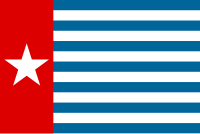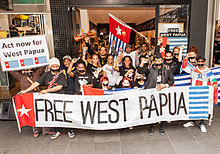
Dutch New Guinea or Netherlands New Guinea was the western half of the island of New Guinea that was a part of the Dutch East Indies until 1949, later an overseas territory of the Kingdom of the Netherlands from 1949 to 1962. It contained what are now Indonesia's six easternmost provinces, Central Papua, Highland Papua, Papua, South Papua, Southwest Papua, and West Papua, which were administered as a single province prior to 2003 under the name Irian Jaya, and now comprise the Papua region of the country.

The national flag of the Netherlands is a horizontal tricolour of red, white, and blue. The current design originates as a variant of the late 16th century orange-white-blue Prinsenvlag, evolving in the early 17th century as the red-white-blue Statenvlag, the naval flag of the States-General of the Dutch Republic, making the Dutch flag the oldest tricolour flag in continuous use. As a flag that symbolises the transformation from monarchy to republic, it has inspired both the derivative Russian flag, and after the French Revolution in 1789, the vertically striped French tricolour; both flags in turn influenced many other tricolours. During the economic crisis of the 1930s, the old Prince's Flag with the colour orange gained some popularity among some people. To end the confusion, the colours red, white and blue and its official status as the national flag of the Kingdom of the Netherlands were reaffirmed by royal decree on 19 February 1937.

The national flag of Indonesia is a simple bicolor with two horizontal bands, red (top) and white (bottom) with an overall ratio of 2:3. It was introduced and hoisted in public during the proclamation of independence on 17 August 1945 at 56 Proklamasi Street in Jakarta, and again when the Dutch formally transferred sovereignty on 27 December 1949. The design of the flag has remained unchanged since.

The Free Papua Movement or Free Papua Organization is a name given to independence movement based on Western New Guinea, seeking the secession of the territory currently administered by Indonesia as the provinces of Central Papua, Highland Papua, Papua, South Papua, Southwest Papua, and West Papua, also formerly known as Papua, Irian Jaya and West Irian.

The Republic of West Papua, alternatively known as the Federal Republic of West Papua is a quasi-state consisting of the Western New Guinea region, which is currently part of Indonesia on the continent of Oceania. The region has been part of Indonesia since 1 May 1963 under several names in the following order, West Irian, Irian Jaya, and Papua. Today the region comprises six Indonesian provinces: Papua, Central Papua, Highland Papua, South Papua, West Papua, and Southwest Papua.

Western New Guinea, also known as Papua, Indonesian New Guinea, and Indonesian Papua, is the western half of the island of New Guinea occupied since 1962 by Indonesia. Given the island is alternatively named Papua, the region is also called West Papua.

Frans Kaisiepo was a Papuan politician and Indonesian nationalist. He served as the fourth Governor of Papua Province. In 1993, Kaisiepo was posthumously declared a National Hero of Indonesia for his lifelong efforts to unite West Irian with Indonesia. As the representative of Papua province, he was involved in the Malino Conference, where the formation of the United States of Indonesia was discussed.
Hai Tanahku Papua was an anthem of Netherlands New Guinea and of the unilaterally declared Republic of West Papua.

New Guinea is the world's second-largest island, with an area of 785,753 km2 (303,381 sq mi). Located in Melanesia in the southwestern Pacific Ocean, the island is separated from Australia by the 150-kilometre wide Torres Strait, though both landmasses lie on the same continental shelf, and were united during episodes of low sea level in the Pleistocene glaciations as the combined landmass of Sahul. Numerous smaller islands are located to the west and east. The island's name was given by Spanish explorer Yñigo Ortiz de Retez during his maritime expedition of 1545 due to the resemblance of the indigenous peoples of the island to those in the African region of Guinea.

The Papua conflict is an ongoing conflict in Western New Guinea (Papua) between Indonesia and the Free Papua Movement. Subsequent to the withdrawal of the Dutch administration from the Netherlands New Guinea in 1962 and implementation of Indonesian administration in 1963, the Free Papua Movement has conducted a low-intensity guerrilla war against Indonesia through the targeting of its military, police, as well as civilian populations.

The New Guinea Council was a unicameral representative body formed in the Dutch overseas territory of Netherlands New Guinea in 1961.
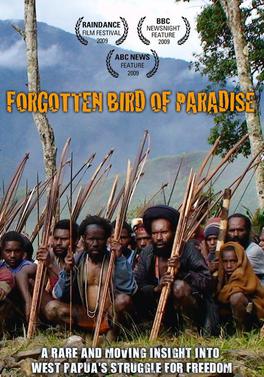
Forgotten Bird of Paradise is a 2009 documentary film directed by British filmmaker Dominic Brown, about the struggle for independence being fought in the Indonesian region of West Papua. The film was shot undercover, and includes interviews with human rights victims and political prisoners, as well as footage of separatist guerrillas at their jungle stronghold.
The History of Western New Guinea refers to the history of the Indonesian western half of the island of New Guinea and other smaller islands to its west. This region was previously named Irian Jaya. The eastern half of the island is Papua New Guinea.
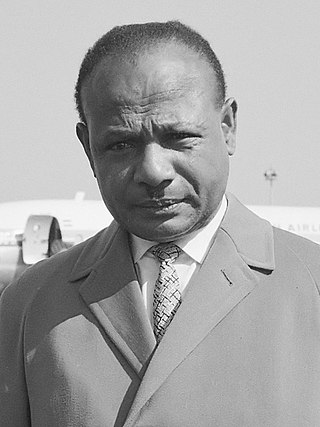
Nicolaas Jouwe was a Papuan leader who was selected to be vice president of the New Guinea Council that governed the Dutch colony of Netherlands New Guinea. As the president of the New Guinea Council was the Dutch civil servant Frits Sollewijn Gelpke, Jouwe was the highest ranking Papuan politician in the colony.

Filep Jacob Semuel Karma was a West Papua independence activist. On 1 December 2004, he helped raise the Morning Star flag at a ceremony in Jayapura, for which he was charged with treason and given a fifteen-year prison sentence. Amnesty International and Human Rights Watch protested on his behalf, the former designating him a prisoner of conscience. He was released on 19 November 2015.
Buchtar Tabuni is a Papuan independence activist, Chairman of the National Parliament of West Papua (PNWP), incorporating the National Committee for West Papua, and United Liberation Movement for West Papua (ULMWP) representative.

Operation Trikora was a combined Soviet-Indonesian military operation which aimed to seize and annex the Dutch overseas territory of Netherlands New Guinea in 1961 and 1962. After negotiations, the Netherlands signed the New York Agreement with Indonesia on 15 August 1962, relinquishing control of Western New Guinea to the United Nations.
Yusak Pakage is an Indonesian activist for Papuan independence, best known for his 2005–2010 imprisonment for raising the pro-independence Morning Star flag.

Silas Ayari Donrai Papare was a Papuan–Indonesian politician and guerilla leader who is a National Hero of Indonesia.
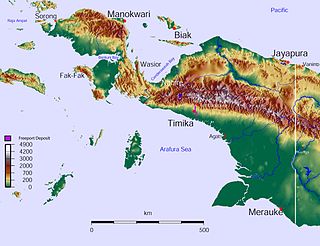
The West New Guinea dispute (1950–1962), also known as the West Irian dispute, was a diplomatic and political conflict between the Netherlands and Indonesia over the territory of Dutch New Guinea. While the Netherlands had ceded sovereignty over most of the Dutch East Indies to Indonesia on 27 December 1949 following an independence struggle, it retained control over its colony on the western half of New Guinea. The Indonesian government claimed this territory as well, on the basis that it had belonged to the Dutch East Indies and that the new Republic of Indonesia was the legitimate successor to the former Dutch colony.
